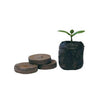
Dutch Bucket Hydroponic Grow System
Dutch Buckets have seen extensive use throughout the US and Europe with great success. These buckets are typically arranged in single rows on the floor or on benches, with one irrigation line feeding from above and one drainage line circulating back to the reservoir from below. Thus each row can be connected and joined together quite easily allowing these systems to be scaled to virtually any size imaginable.
Like most hydroponic setups, Dutch Buckets can be used in both Hydroponics and Aquaponics, although Hydroponics is much simpler and without a doubt the most reliable and easily controlled plant feeding method.
Growing Media
Expanded Clay Pebbles, also known as Hydroton/LECA (Light Expanded Clay Aggregate) is known to be the ideal medium for re-circulating, Flood & Drain, and high volume hydroponic plant cultivation systems.  Expanded Clay Pebbles have the ability to maintain elevated levels of moisture and oxygen, and have the best drainage and aeration capabilities between all hydroponic growing mediums. They are too large to enter the Dutch Bucket drainage system so you will never have to worry about your siphon elbow getting blocked.
Expanded Clay Pebbles have the ability to maintain elevated levels of moisture and oxygen, and have the best drainage and aeration capabilities between all hydroponic growing mediums. They are too large to enter the Dutch Bucket drainage system so you will never have to worry about your siphon elbow getting blocked.
Mediums that retain too much moisture can lead to flooding and/or run the risk of entering the drainage system, circulating back to the reservoir where blockages and clogging issues are likely to occur. Perlite is also a popular choice of medium used in Dutch Bucket systems due to its increased drainage, water retention and aeration. However certain measures need to be put in place to prevent the medium from draining back to the reservoir as the particles are much smaller than the pebbles.
If you are using mediums that retain water and are slow to drain such as Coco Peat, the Drain to Waste method is advised. Alternatively low volume drip irrigation can be used. This is not recommended while using Dutch Buckets as this defeats the purpose of the high volume re-circulating hydroponics system in the first place.
Reservoir and Circulation
The reservoir, in most setups is located below the level of the Dutch Buckets. This is to allow gravity to be the driving force behind returning the nutrient solution back to the reservoir. It is then pumped back through  the feed-line via a Submersible Water Pump directly to each Dutch Bucket where it will rapidly drain through the pebbles back to the reservoir, repeating the cycle. This is the most effective and economical method of use for the Dutch Bucket system and is highly recommended due to the rapid growth and notable water savings experienced by growers.
the feed-line via a Submersible Water Pump directly to each Dutch Bucket where it will rapidly drain through the pebbles back to the reservoir, repeating the cycle. This is the most effective and economical method of use for the Dutch Bucket system and is highly recommended due to the rapid growth and notable water savings experienced by growers.
Nutrient Solution
The nutrient solution within the reservoir is aerated using a Air Pump & Air Stone. Your nutrient solution needs to be maintained on a daily basis and completely exchanged once a week by adding fresh water and nutrients. The levels of TDS (Total Dissolved Solids) and pH (potential of Hydrogen) should be closely monitored in order to achieve a completely balanced solution for the specific requirements of your plants. It is highly recommended to invest in the best quality pH & TDS/EC water meters and Hydroponic plant Nutrients available.
Planting in a Dutch Bucket
Seedlings and cuttings are usually propagated  and rooted in Coco Peat Pellets and/or Rockwool Starter Plugs. Once roots emerge, the young plants are planted into the Dutch Bucket system where rapid growth takes place.
and rooted in Coco Peat Pellets and/or Rockwool Starter Plugs. Once roots emerge, the young plants are planted into the Dutch Bucket system where rapid growth takes place.
Dutch Buckets are the perfect Hydroponic system for any horticulturist looking to get the most out of their grow space. Whether cultivating indoors in a grow tent environment with only a few buckets, or in greenhouses with rows and rows of buckets, their simplicity and ease of use remains.
Many have attempted to recreate the Dutch Bucket with a DIY approach but have experienced sub par results, this is mainly due to the very specific design of the Dutch Bucket’s siphon elbow and its ability to maintain just the right amount of nutrient solution and drainage flow within the bucket. There is a large selection of online guides and articles on how to build your own yet none have seen the results that can be achieved while using the original Dutch Bato Bucket design.
mainly due to the very specific design of the Dutch Bucket’s siphon elbow and its ability to maintain just the right amount of nutrient solution and drainage flow within the bucket. There is a large selection of online guides and articles on how to build your own yet none have seen the results that can be achieved while using the original Dutch Bato Bucket design.


Comments
Leave a comment